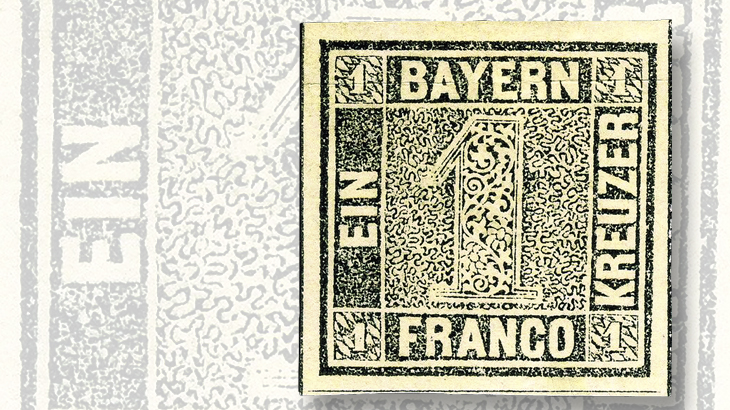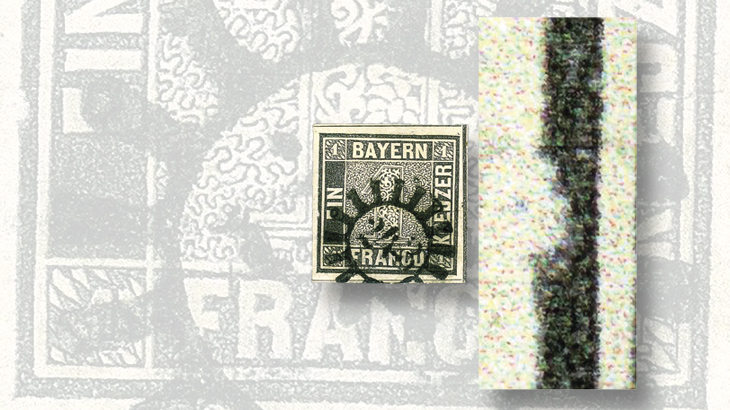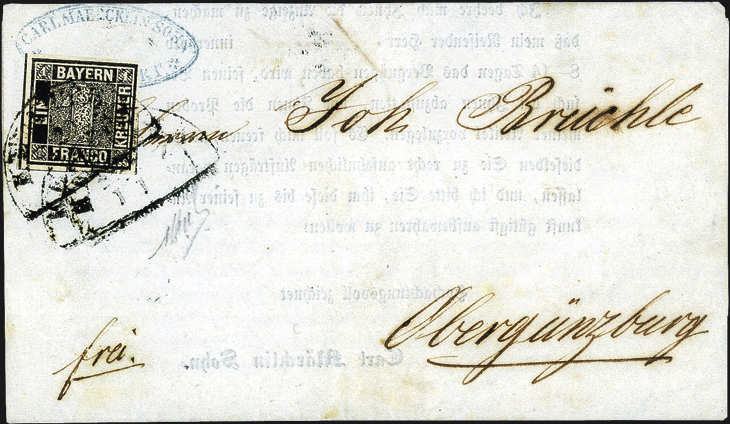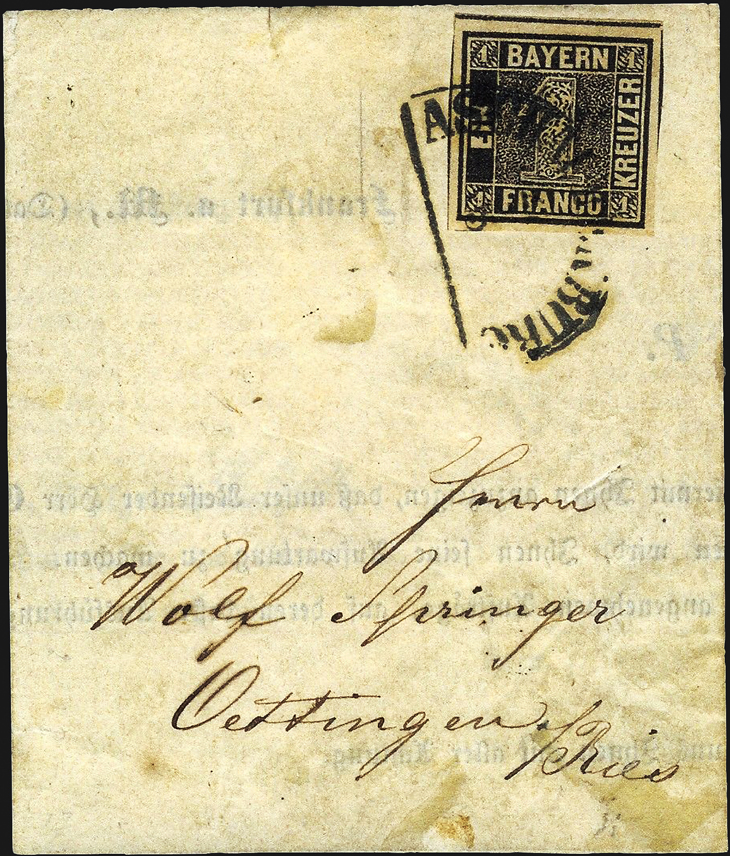World Stamps
Bavaria’s first stamp surprised post office patrons: Unveiling Classic Stamps
By Sergio Sismondo
In the morning of Thursday, Nov. 1, 1849, Bavarians who went to their post offices were confronted with notices posted on the walls announcing “Stamps for the Prepayment of Postage on Letters and Printed Matter are now Available for Sale.” On that day, the Kingdom of Bavaria joined the small club of European nations that had introduced stamps for prepayment of postage.
In previous columns, I have given brief accounts of events that preceded the issuing of postage stamps in Great Britain, Belgium, and France. In the Americas, Brazil and then the United States also were quick to imagine the benefits of postal reform in general, and specifically the benefits to the post offices of prepayment of postage by means of stamps.
The Bavarian Post Office carried out a postal reform in early 1849. On July 1, 1849, a set of postage rates went into effect. It was as straightforward as any.
Connect with Linn’s Stamp News:
Sign up for our newsletter
Like us on Facebook
Follow us on Twitter
What all this meant was that stamps were needed in the denominations of 1 kreuzer, 3kr and 6kr. Higher denominations followed a few years later: 12kr in 1858 and 18kr in 1854. Obviously there had not been a huge demand for franking of heavy letters, money letters, or letters going across the oceans.
However, for the basic categories of mail the demand was substantial. On a per capita basis, it was higher than in most countries in Europe. In 1852, there were 15.8 million letters mailed, 24.1 million newspapers mailed, and 3.1 million packets mailed.
Because prepayment was optional, and on the basis of the experience in Great Britain, Belgium and France, it was estimated that initially perhaps only 10 percent of the mail would be prepaid. Therefore, a small initial printing was sufficient, though the numbers seem to me strangely small, in view of the total picture.
The artist and stamp designer was Max Joseph Seits. The printing task was given to the Johann Georg Weiss University Printing Works — and a good job they did. The design emphasizes the numeral “1,” which is large and dominates the center, is repeated in each of the four corners, and is spelled out for a sixth appearance on the left side — “EIN.” No wonder the stamp is affectionately known in Bavaria as the “Der Schwarze Einser,” roughly translated as “the black singleton.”
Other colors were considered; trial colors exist in blue and pale lilac. Nevertheless, the Bavarian postal executives followed the trail of their predecessors in Great Britain, Brazil, and France, and made their first stamp black. The lower cost of black ink might have been a factor. There were also proofs with red silk thread embedded in the paper, considered to be a security device, but that line of thinking was also put aside for eventual consideration.
The operation at University Printing went smoothly and on time. Appropriate machine-made paper was ordered, without watermark and without silk thread. A large hardened metal plate was made with four quarters, separated horizontally by generous gutters and vertically by an extra frameline. Each quarter consisted of five stamps across, in nine rows: that is, 45 stamp images or 180 stamps to a sheet. A first printing, known now as plate 1, consisted of 472,500 stamps (according to Thomas Henke’s Altdeutsche Staaten Spezialkatalog and Peter Sem’s Bayern Spezialkatalog, Vol. 1, Handbook Kreuzerausgaben (Kreuzer Issues Handbook), 7th edition).
Michel’s Deutschland-Spezial 2015 lists the quantity at 554,760. Thus, at least 2,625 sheets were produced apparently without difficulty. But the plate began to show wear, and the cautious printers, with characteristic foresight, set out to produce a second plate, much before it was needed.
Printing from plate II began Oct.1, 1849, even before the sale of the first stamps was inaugurated, and continued until February 1850. Stamps from plate II first began arriving at post offices in April 1850. Apparently, people in this little kingdom knew how to plan and how to get things done.
The difference between the two plates is relatively simple to detect. In plate I the thin lines, which form a frame of the large “1” in the center, were faintly drawn, with numerous breaks (discontinuities). If the cancellation permits, these breaks are most easily seen in the left serif at the bottom of the numeral, where they are often entirely missing.
Not only that, but as the plate wore, the breaks became more pronounced. This needed correction. In the making of plate II, these thin frames around the numeral were strengthened and are consistently complete throughout the printing. From this plate, at least 2,000 sheets were printed, which translates to 360,000 stamps (again, according to Henke and Sem, but 378,000 according to Michel). In this second printing, the methodology for hardening and finishing the plate must have been improved, because there are almost no signs of plate wear in the stamps from plate II. Shown nearby are examples of stamps from plate I unused and plate II used.
Postal rates and uses
Looking at the rate table accompanying this article, we see that most “Schwarze Einser” stamps should be found on local letters and printed matter. Local letters in good condition are scarcer than fronts and other fragments of newspaper and periodicals.
Shown nearby are two examples of printed matter items. One originates in Wurttemberg but was posted in Kempten, Bavaria, to save postage on what was probably a large mailing. The cover is dated 20/11, and is addressed to Obergunzburg, Bavaria. The other is from Ascheffenburg, dated 2/5 and addressed to Oettingen, Bavaria.
Values depend greatly on how the stamp was canceled. The least expensive examples are those with only pen cancellation. With both pen cancellation and canceler they normally fetch a little more. But examples canceled with only town or town-dated postmarks are worth at least double. The same order of things applies to covers with single frankings. Both items illustrated here are premium items of this last category.
Curiously, the highest value single frankings are those on the address labels for newspapers and periodicals. In fact, our firm has only handled one example, and looking through major classic Bavaria auctions of the past two decades we cannot find any examples on address labels.
Plate flaws and errors
There are few plate flaws or other varieties of the 1kr black stamp. Six constant varieties that attract attention are listed and illustrated in specialized catalogs. There is a broken “A” in “FRANCO”; a broken “F” in “FRANCO”; a broken “E” in “EIN” (two types); a crack in the lower-right corner square box, which affects the frame; and a few other more minor varieties, which some would include in the philatelic category of “flyspecks.” All these listed varieties occur in plate I stamps. Plate II stamps have fewer and less noticeable flaws.
Gutter pairs exist, saddling two panes from the sheet; very few are known and their value is astronomical. A sheet showing a pronounced double impression must have escaped incineration. The stamps only are known unused and without gum. Several multiples are known. All of which suggests careful preservation of what should have been a printer’s rejected sheet. Tradition has placed this variety in all the catalogs, and all major Bavaria exhibit collections have at least one example.
And then we come to the truly major variety: Like in French stamps, there was an inverted cliche that produced tete-beche pairs. The error must have been quickly corrected, because very few examples are known (three singles only), in addition to what may be seen in two famous complete sheets, which are really museum pieces.
Stamps of this issue are normally canceled with pen strokes, with or without additional postmarks. The postmarks may be straight-line markings from the stampless period; town datestamps in semicircle frame, which were brought out on Nov. 1, 1849, simultaneously with the unveiling of the first stamps.
On Aug. 1, 1850, the cogwheel numeral postmarks were introduced in a first distribution to 402 post offices. These attractive postmarks, therefore, are found canceling 1kr stamps from the first and second plates. Values vary, however, because the earliest styles of postmarks are more often found on stamps from plate I, while the later styles are more often found in stamps from plate II.
For postmark specialists, the issues get more interesting because there were several further distributions of “cogwheels” to post offices, and there were at least two styles of cogwheels as well. They are known as “closed cogwheels” (“mühlrad gesschlossen”) and “open cogwheels” (“mühlrad offen”).
To determine values for different postmarks — from different towns, and different combinations — it is essential to obtain specialized postmark catalogues. (Hans Grobe’s Altdeutschland Spezial-Katalog und Handbuch, 5th edition; the Henke catalog; Sem handbook; and Peter Feuser’s Die Nummernstempel der Altdeutschen Staaten, 1992, offer four excellent examples.) Unfortunately, for those who have difficulty with the language, all the text and explanations in the four books are written in German.
Returning to the subject of plate flaws, we have found a stamp from plate II with a new flaw. When we first acquired the stamp, we did not pay much attention to the frame break at left just on the side of the “E” of “EIN.” Then a German student of classic issues, a friend of mine whom I have known since my youth and with whom I have exchanged much information through the years, saw my stamp and said with great surprise: “You have one too.”
I asked what in heaven he was talking about, and he explained that he had found a 1kr from plate II with this flaw, which has never before been recorded even in the most specialized literature. He said my stamp was the third example noted.
We then checked with all the expertizers of Bavaria stamps in Germany to see if they had ever recorded this variety. The result of those inquiries was negative. Of course, both he and I have looked at every 1kr stamp we came across with great expectation of finding other examples. But three years have gone by, and no other example has come to his or my attention.
To be doubly sure, I recently telephoned my friend to know if there were any news of our little precious find. He assured me that nothing new has happened on that subject.
Therefore, the stamp pictured with this column, with the numeral “243” cogwheel cancellation of Nurnberg, and showing the frame break at left, is still one of only three examples recorded with that flaw. Maybe it is a flyspeck, but it is a fun chase for a previously unrecorded variety of one the earliest and most famous stamps of the world.
Related articles:
Identifying Belgium’s first stamp issue: the Epaulettes of 1849
Identifying Brazil’s Bull’s Eyes corresponding plates can be fun
MORE RELATED ARTICLES
Headlines
-
US Stamps
Oct 7, 2024, 3 PMMcMurtrie dismissed as APS education director following Sept. 21 arrest
-
US Stamps
Oct 7, 2024, 12 PMVasiliauskas named president of Mystic Stamp Co.
-
US Stamps
Oct 6, 2024, 5 PMApgar souvenir card available
-
US Stamps
Oct 6, 2024, 4 PMFirst Continental Congress and U.N. stamps receive Scott catalog numbers









